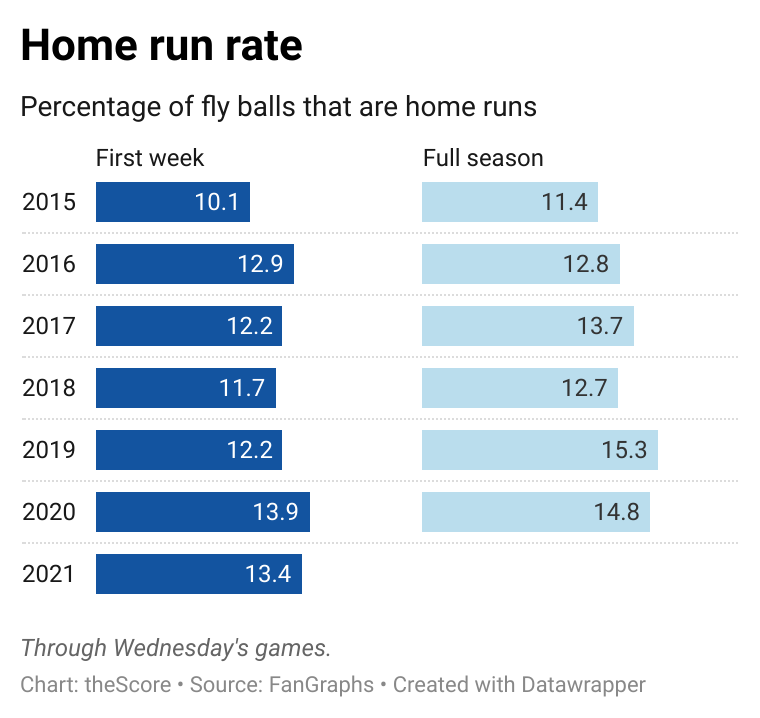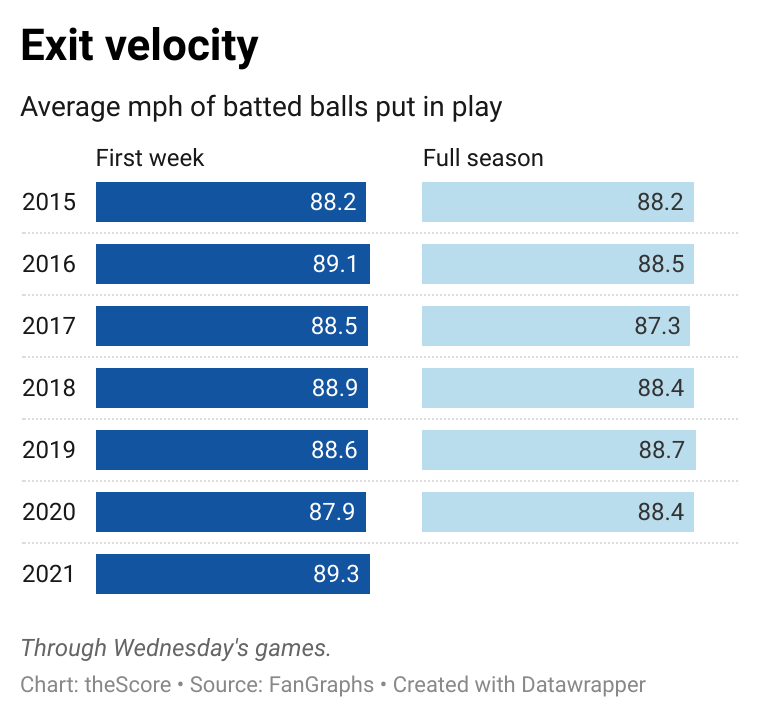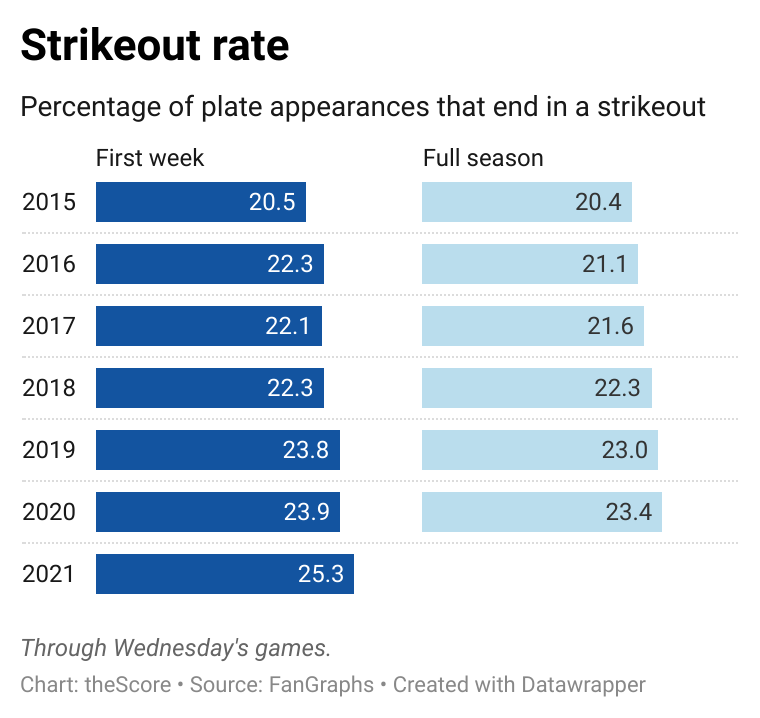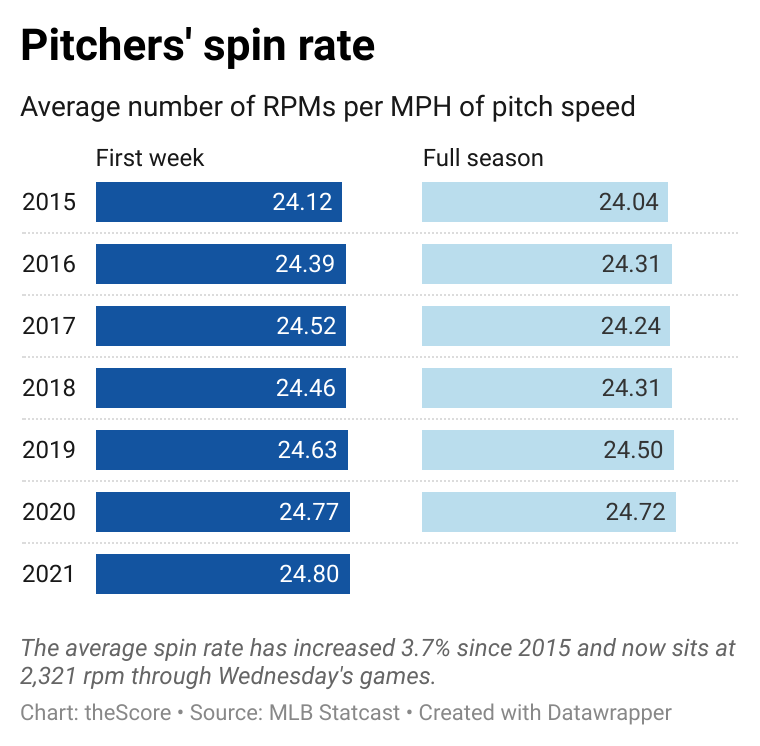What the 1st week can tell us about the rest of the MLB season
We tell ourselves to not make too much of early-season performances. After all, it's a six-month grind. Baseball players and teams go through peaks and valleys.
Sometimes those heights or lulls are early in a campaign. White Sox rookie Yermin Mercedes probably won’t lead the league in batting, and the Rangers' Nate Lowe is probably not going to challenge Hack Wilson's RBI record. But some things do matter early, some levels of league-wide performance stabilize quite quickly.
Recent history suggests there's much to be gleaned from MLB-level data after just one week of play. This year that includes aspects of the game that are under the microscope: how the new baseball is playing, the strikeout-rate trend, and the quality of batted balls.
Many of the measures of performance do not differ much from where they stand after the first week of play to where they finish at the end of the season. And for a commissioner’s office that wishes to reduce home runs and strikeouts, the early-season numbers are so far defying those objectives.
After one week of play this year, 13.4% of fly balls are going over the fence, which is down 0.5 percentage points from last year, a season that began in July. This year’s first-week HR/FB ratio is the highest of any season that began in March or April during the Statcast era (2015-present).
In five of six years since 2015, those end-of-season percentages increased, on average, 1.3 percentage points from where they stood after one week, presumably because temperatures warm across the continent as the season goes on. So if home runs inch up as they typically do, the sport could be looking at home-run rates similar to those of recent years, which are what prompted cries to de-juice the ball.

But isn’t the ball different? Less lively? MLB announced earlier this year that Rawlings was manufacturing a ball that would travel a few feet less when driven in the air long distances, and experts such as Alan Nathan, who analyzed the tests, said the "desired effects" of deadening the ball were achieved.
Tampa Bay Rays pitcher Tyler Glasnow told me he believes long fly balls are not traveling quite as far this season.
"There have been some balls off the barrel this year that sounded like no-doubters, but have stopped at the warning track," Glasnow said. "It seems a bit different to me."
Rockies outfielder Charlie Blackmon told The Athletic he feels the new ball is less lively.
"I do know that a couple of balls Trevor (Story) hit that maybe were home runs in the past but now that we changed the ball slightly weren't home runs this past series,” Blackmon said earlier this week.
So why are we not seeing a significant decrease in home-run rate early this season? Well, MLB batters are crushing the ball.
Average exit velocity stands at 89.3 mph after one week, which marks the highest early-season reading in the Statcast era. Last season, the first-week average was 87.9 mph. The average projected fly ball distance stands at 318 feet this year compared to last season’s average of 311 feet. On average, batters are making better contact.
But Glasnow and Blackmon are on to something in regard to what they've observed anecdotally.
The rate at which pitches have been "barreled" by MLB batters - meaning contact that has an ideal exit velocity and launch angle - is at an all-time high through one week, 8.1% of all balls in play. That's nearly double the 2015 rate. Moreover, those most-well-struck pitches have averaged an exit velocity of 105.3 mph. Yes, another record. Yet the projected distance of contact in this cohort has fallen from 390 feet last year to 383 this year, which may speak to a less lively baseball. The balls that are being launched the farthest are covering slightly less distance, according to Statcast.

Exit velocity appears to be a measure that normalizes quickly. Exit velocity readings at the end of Week 1 are typically not too different from the end-of-season average, so this could be the hardest-hit rate year on record. And it makes some sense. After all, batters are improving their swings and skills just as pitchers are learning how to throw faster fastballs and sharper breaking balls. So it's possible that MLB inadvertently created the perfect ball to keep home runs in line with recent season rates and negate improvement from hitters.
It could also be that the new ball is bouncier off the bat, as some analysts believe from reviewing the early evidence, but also one with more drag that reduces distance on long fly balls. Either way, recent history suggests exit velocities will be at record highs.
Perhaps the most troubling early-season trend for MLB, one that tends to hold throughout the season, is that strikeout rates are up again.
After one week, a quarter of plate appearances are ending with a strikeout (25.3%), which is yet another major-league record, breaking the mark of 23.9% set last year (which broke the mark of 23.8% set in 2019). On average since 2015, strikeout rates finish the year a half a percentage point lower from the level they stood after one week.

This doesn’t seem like a fluky jump. The average fastball velocity so far is a pitch-tracking-era record for a first week, 93.5 mph, and that number tends to stay stable throughout the season.
Through the first week, the sport is also seeing another increase in spin rate, which governs the movement of pitches. More spin leads to more lift on fastballs, more break on curveballs and sliders, and more fading action on changeups. More spin means more strikeouts.
There are two ways to increase spin: add more velocity, or with the use of sticky substances like pine tar applied to the pitching hand. Sticky stuff is outlawed by rule, but many pitchers employ it. MLB issued a memo this spring claiming it was going to crack down on pitchers using illegal substances by tracking spin-rate improvements, ostensibly to try and reduce strikeouts.
When accounting for velocity, spin rate per mph has increased in the first week for the last three years. It remains to be seen if MLB will try to enforce the rule by giving suspected pitchers citations because of their Statcast data - something akin to being mailed a speeding ticket because of a traffic camera. If MLB does nothing, history suggests 2021 will mark a record high for spin rate.

It seems MLB’s goal to deaden the ball and force more batted balls into play might be backfiring: Strikeouts are the main culprits for the lack of action and they are on the rise. Meanwhile, a deadened ball, should hitters not keep their early exit-velocity gains, could sap the game of run-scoring.
It's early, but if recent history is a reliable guide, then after the first week the game seems to be continuing on its march toward more strikeouts and homer-dependent run generation. And that'll likely continue to lead to more questions about whether this path is good for the game and what exactly can be done about it.
Travis Sawchik is theScore's senior baseball writer. Follow him on Twitter at @Travis_Sawchik.